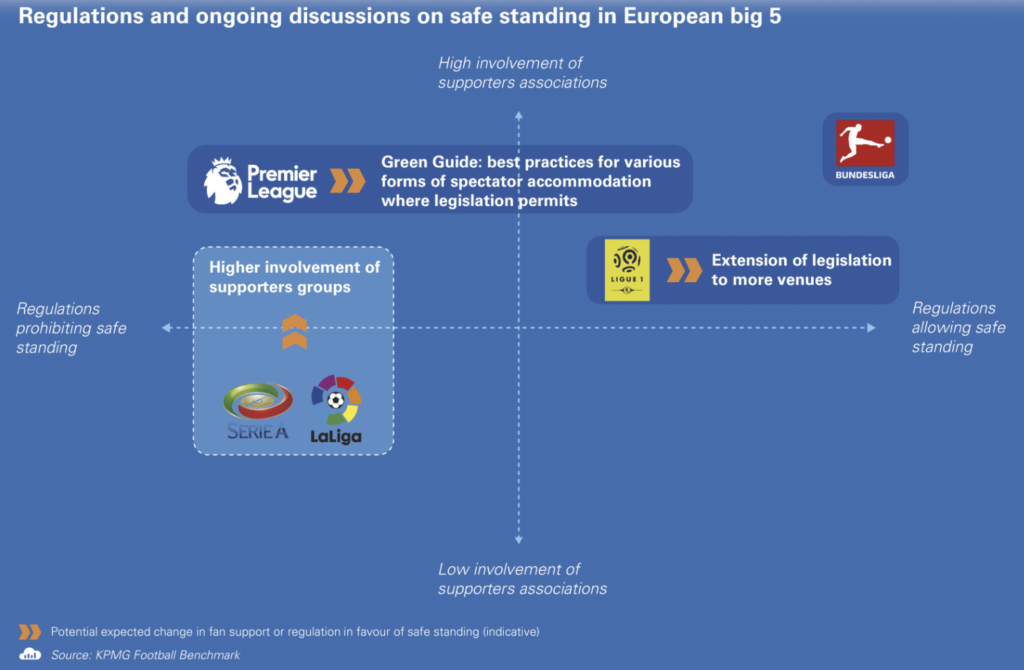October 4 – A KPMG Football Benchmark study into the possibility of re-introducing standing-only for areas in stadia in the top divisions of England, France, Germany, Italy and Spain concludes that with the new safety measures available, the commercial and fan engagement opportunity for clubs merits a hard re-visitation of regulations in countries that still have a standing ban.
For more than 20 years, standing has been prohibited at most top-flight stadia across Europe, with all-seater grounds being in place in England and Wales since 1994 and Italy’s Serie A since 1996, with tragic incidents and hooliganism having been the main catalysts for all-seat requirements.
However, with stadiums turning into modern, security-conscious venues and fans increasingly demanding more atmosphere, there have been moves to look at the re-introduction of standing areas.
This is evidenced in Germany, where standing has never been banned. Borussia Dortmund can have up to 15,000 extra paying customers for a Bundesliga game than for a Champions League game as they can convert their stadium from the all-seater configuration prescribed by UEFA to a mixture of seating and standing, a conversion that could be permissible in other European leagues, allowing for increased capacity and revenue without making large changes to the stadium design.
Currently, in Italy and Spain, where all top level grounds have been all-seater since the late-1990s, there are currently no signs of any shift in the regulatory position that would open-up the potential for this. However, the situation in England and France appears to be shifting.
In France, the government introduced a trial of standing areas earlier this year, with AS Saint-Etienne and Amiens SC in Ligue 1 and RC Lens and FC Sochaux-Montbeliard in Ligue 2 taking this on in September. This included barriers at Saint-Etienne and more conventional terracing at the other stadiums.
In England, this involved Celtic using rail seating at their stadium (Celtic, as a Scottish club, are not subject to the all-seater policy in England), while Tottenham Hotspur have announced that when their new stadium is opened, it will include “seating incorporating barriers”, while recent polls reveal that a large majority of Premier League supporters are in favour of the reintroduction of standing areas.
With stadium disasters such as Bradford and Hillsborough still fresh in the memory, however, any move to revive terracing or introduce convertible seating would need to be handled sensitively and with safety at the forefront of discussions.
Any new ground development or adaption will inevitably come with increased costs for clubs, although this could be offset by cost efficiencies – one of them being saving money through not having to replace broken seats every season – derived from more flexible and robust stadium accommodation.
Historically, standing admission prices have been lower than seating, but in the medium-term clubs could decide to recoup their investment through the turnstiles. Other benefits are more aesthetic, ranging from a dynamic ambience due to the reintroduction of standing, producing a more vibrant product that will undoubtedly appeal to TV broadcasters and sponsors – with La Liga’s introduction in 2016 of fines for clubs leaving empty seats in view of TV cameras recognising this.
With the ongoing trials in France, the government review of the all-seater policy in England, the continued success of standing in Germany and the imminent publication of the new best practice guidelines, the report champions the case for rule changes.
See the full report at https://www.footballbenchmark.com/is_the_time_right_for_safe_standing
Contact the writer of this story at james.vukmirovic at moc.l1744972798labto1744972798ofdlr1744972798owedi1744972798sni@o1744972798fni1744972798


